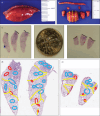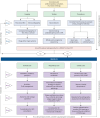An interdisciplinary consensus approach to pulmonary hypertension in developmental lung disease
- PMID: 39147412
- PMCID: PMC11424926
- DOI: 10.1183/13993003.00639-2024
An interdisciplinary consensus approach to pulmonary hypertension in developmental lung disease
Abstract
It is increasingly recognised that diverse genetic respiratory disorders present as severe pulmonary hypertension (PH) in the neonate and young infant, but many controversies and uncertainties persist regarding optimal strategies for diagnosis and management to maximise long-term outcomes. To better define the nature of PH in the setting of developmental lung disease (DEVLD), in addition to the common diagnoses of bronchopulmonary dysplasia and congenital diaphragmatic hernia, we established a multidisciplinary group of expert clinicians from stakeholder paediatric specialties to highlight current challenges and recommendations for clinical approaches, as well as counselling and support of families. In this review, we characterise clinical features of infants with DEVLD/DEVLD-PH and identify decision-making challenges including genetic evaluations, the role of lung biopsies, the use of imaging modalities and treatment approaches. The importance of working with team members from multiple disciplines, enhancing communication and providing sufficient counselling services for families is emphasised to create an interdisciplinary consensus.
Copyright ©The authors 2024.
Conflict of interest statement
Conflict of interest: E.D. Austin reports grants from the NIH and a leadership role with TBX4Life. C. Galambos reports leadership roles with PPHNet and TBX4Life. D. Yung reports grants from Merck, Janssen and the NIH. S.O. Vargas reports grants from the Chan Zuckerberg Initiative, consultancy fees from Vertex Pharmaceuticals, lecture fees from the American Academy of Allergy, Asthma & Immunology, participation on a data safety monitoring board or advisory board with Millipore Sigma, and a leadership role with the Society for Pediatric Pathology. E.O. Jackson reports support for attending meetings from Seattle Children's Hospital. E.C. Whalen reports consultancy fees from the Pulmonary Hypertension Association Care Center and a leadership role with PPHNet. N.M. Villafranco reports support for attending meetings from the Children's Hospital of Philadelphia. S.H. Abman reports grants from the NHLBI (U01 HL12118), consultancy fees from Chiesi, and participation on a data safety monitoring board or advisory board with Bayer Pharmaceuticals and the NHLBI. The remaining authors have no potential conflicts of interest to disclose.
Figures





References
Publication types
MeSH terms
LinkOut - more resources
Full Text Sources
Medical
